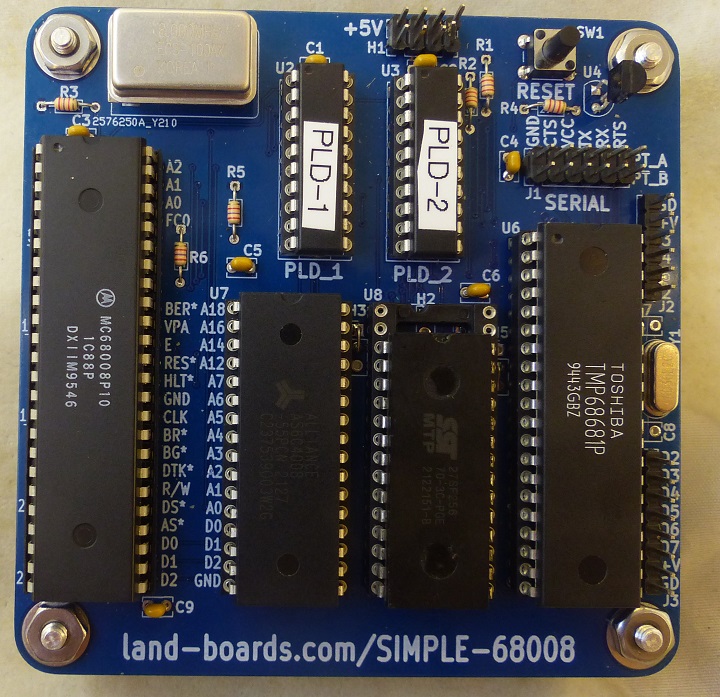
Features
- 68008 CPU
- 20 bit address space (1MB total)
- 10 MHz clock
- 128KB/512KB SRAM
- Up to 448KB EPROM/EEPROM
- 68681 Dual Serial Port (ACIA)
- Headers for FTDI
- 38,400 baud
- Reset switch with optional Power Supervisor
- 5V operation
- 95x95mm card
- (4) 6-32 mounting holes
Memory Map
- The memory map depends on two things
- Mapping in the PLDs
- The firmware that is being run on the card
Maximal Capacity Design
- 0x00000-0x7FFFF 512KB SRAM
- 0x80000-0xEFFFF Up to 448KB EPROM (minus DUART I/O space)
- 0x80000-0x87FFF 27C256 (322KB)
- 0x80000-0x8FFFF 27C512 (64KB)
- 0xF0000-0xFFFFF Serial (ACIA)
Chip Set

Parts in "Kit"
- MC68000P10 - 68K CPU with 16-bit data bus and 24-bit address bus
- MC68230P8 - Parallel I/O bits, timer
- TMP68681P - Dual UART, 8-bit I/O, 6-bit I/O
- MC68901P - Multifunction (8 I/O pins, interrupt controller, (4) timers, UART
- AM8511A - Floating Point Unit
- MC68008P10 - 68K CPU with 8-bit data bus and 20-bit address bus
- 65B50P - ACIA (Serial interface)
Design
CPU
- The Motorola 68008 is an 8/32-bit microprocessor introduced by Motorola in 1982
- It is a version of 1979's Motorola 68000 with an 8-bit external data bus, as well as a smaller address bus
- This card uses a 68008 with 20 address lines (48-pin package) which allowed 1 MB address space versus the 16 MB addressable on the 68000
- Rev 1 needs a wire jumper U5-39 to U5-40 to pull up VPA*
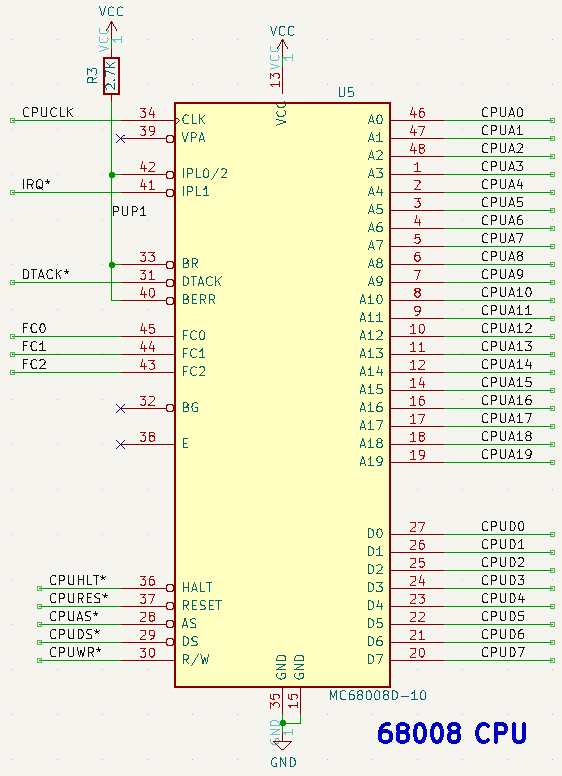
CPU Timing


Function Code

EPROM
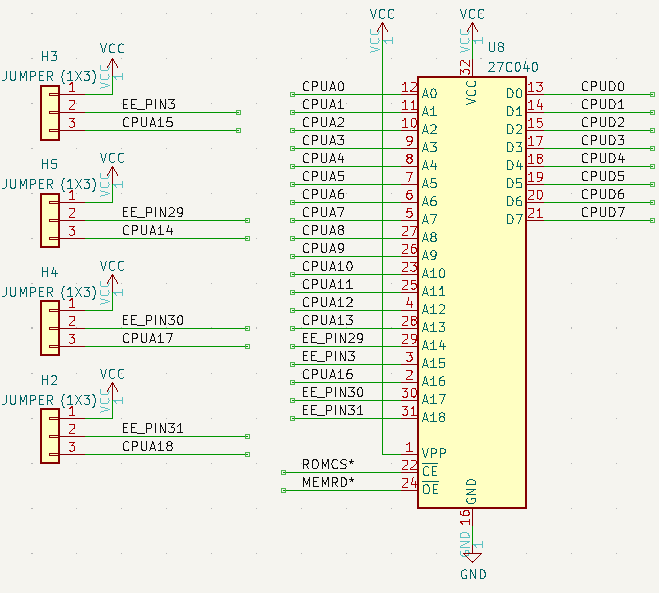
- SST27C256 EEPROM
- 32 KB part
- 28 pin part, 32 pin socket
Flash Memory (EEPROM) Programming
- Program using TL-866ii plus programmer
- Select device type
- Using SST 27SF256 part (Part is 32 KB)
- File Open
- Select file = S68K_001.hex
- File format: INTEL_HEX
- To Region: Default
- Set EPROM offset when file is loaded to accommodate memory map offsets for EPROM space
- Set From File Start Addr(Hex) to 80000
- To Buffer Start Addr(Hex) to 00000 (should be already that value)

- Got Device ID error
- Turn off ID checkbox in the Options section (bottom left of window)
- Device programmed/verified
- Memory Buffer should look like

Device ID Mysteries
- Ebay has parts with SST marking
- EPROM Programmer says the parts are WinBond (Manufacturer ID 0xDA)
- Part marked as 27SF512 and it's a 27C512 (Part ID 0x08)
- Windbond 27C512 qty 10 are cheaper than SST part on ebay
SRAM
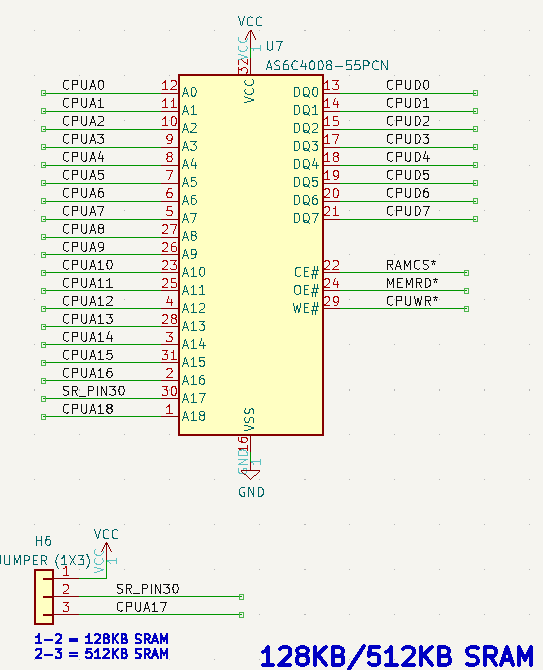
- Using 512 KB SRAM
- Wire jumper H6-2 to H6-3 on rear of card
Dual UART
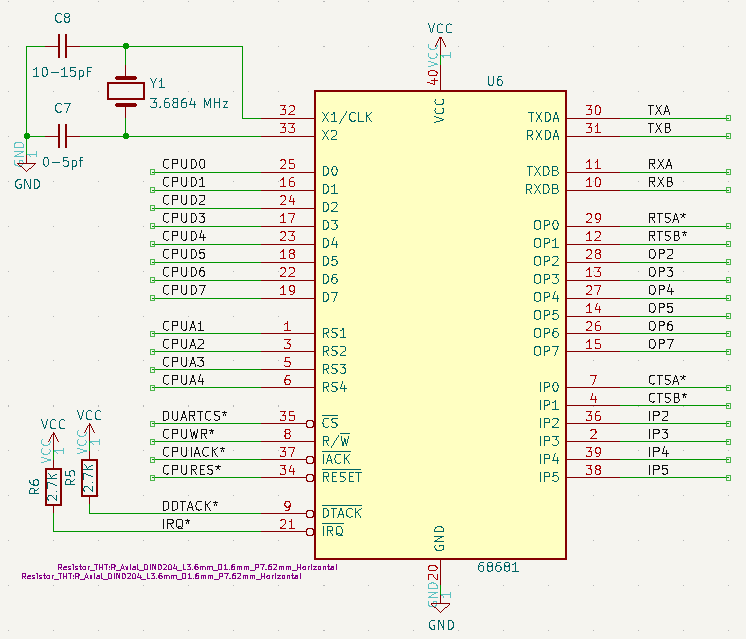
Reset
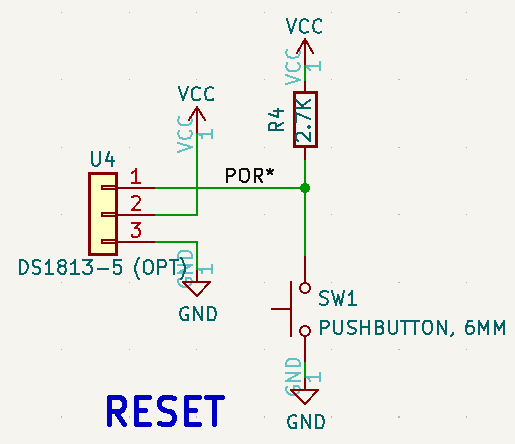
Clock
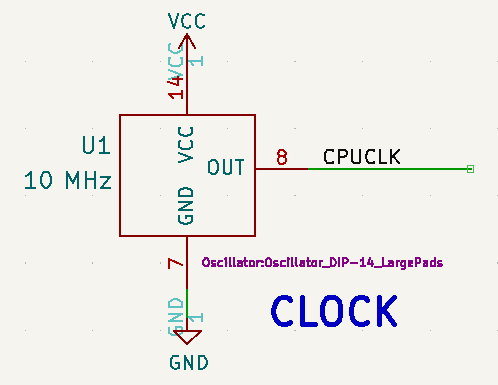
- Test and works with 8 MHZ and 10 MHz crystal oscillator
PLDs
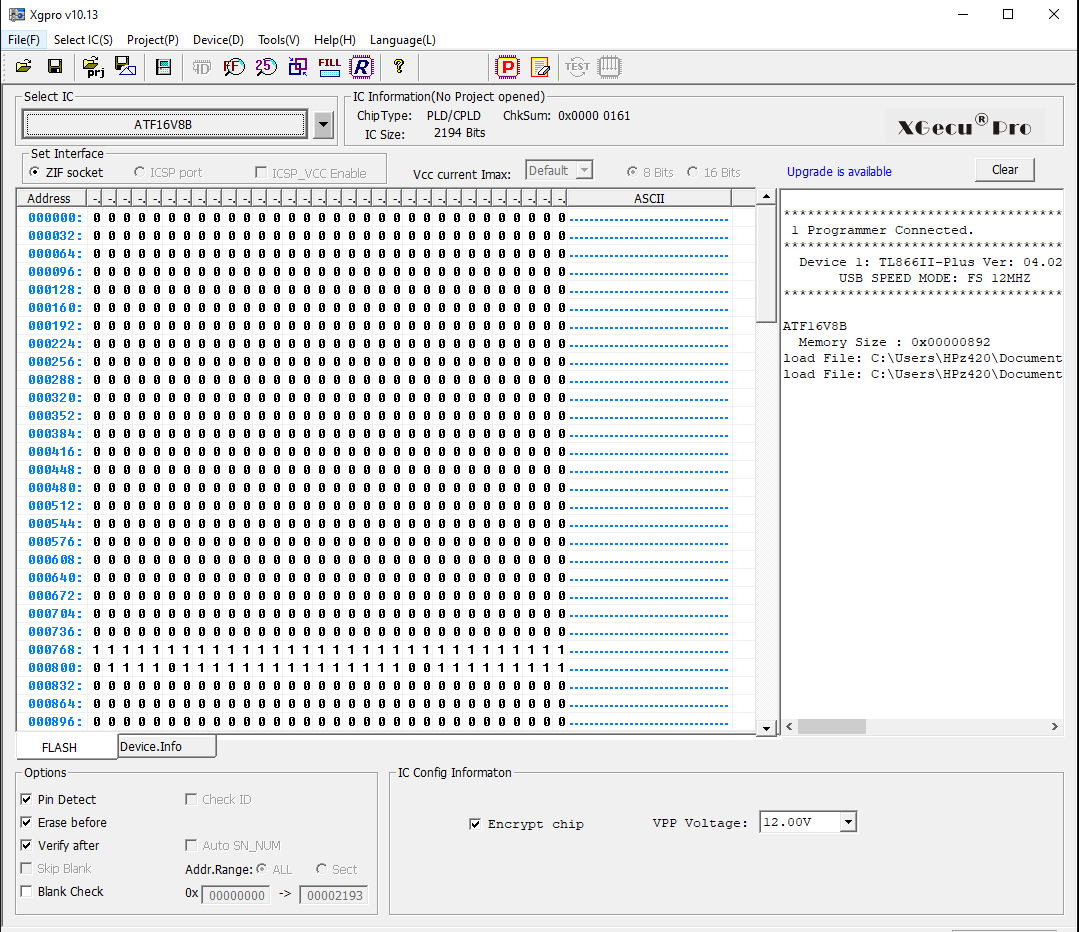
PLD_001

PLD_001 Source Listing
Name SIMPLE-68008_PLD_1;
Partno ATF16V8B;
Date 07/13/24;
Revision 01;
Designer DOUG G;
Company LAND BOARDS LLC;
Assembly U02;
Location RUSTBELT, USA;
Device G16V8;
/*
*/
/* Inputs */
PIN 1 = CLK;
PIN 2 = !CPUAS;
PIN 3 = !CPUDS;
PIN 4 = CPUA16;
PIN 5 = CPUA17;
PIN 6 = CPUA18;
PIN 7 = CPUA19;
PIN 8 = CPUFC0;
PIN 9 = CPUFC1;
PIN 11 = CPUFC2;
PIN 12 = !DDTACK;
PIN 13 = SWAP;
/* Outputs */
PIN 14 = !CPUIACK;
PIN 15 = !DUARTCS;
PIN 16 = !CPUDTACK;
PIN 17 = WAIT1;
PIN 18 = !RAMSEL;
PIN 19 = WAIT2;
CPUIACK = CPUA19 & CPUA18 & CPUA17 & CPUA16 & CPUFC2 & CPUFC1 & CPUFC0 & CPUDS;
DUARTCS = CPUA19 & CPUA18 & CPUA17 & CPUA16 & CPUDS & !CPUFC1 & CPUFC0;
RAMSEL = !CPUA19 & SWAP & CPUDS & !CPUFC1 & CPUFC0 /* User/Super Data */
# !CPUA19 & SWAP & CPUDS & CPUFC1 & !CPUFC0; /* User/Super Program */
CPUDTACK = CPUA19 & CPUA18 & CPUA17 & CPUA16 & CPUDS & !CPUFC1 & CPUFC0 & DDTACK /* DUART Data spaces */
# CPUA19 & CPUA18 & CPUA17 & CPUA16 & CPUDS & CPUFC2 & CPUFC1 & CPUFC0 & DDTACK /* DUART IACK space */
# CPUA19 & !CPUA18 & CPUDS /* EPROM */
# CPUA19 & !CPUA17 & CPUDS /* EPROM */
# CPUA19 & !CPUA16 & CPUDS /* EPROM */
# !CPUA19 & CPUDS; /* RAM */
PLD_002

PLD_002 Source Listing
Name SIMPLE-68008_PLD_2;
Partno ATF16V8B;
Date 06/19/24;
Revision 01;
Designer DOUG G;
Company LAND BOARDS LLC;
Assembly U03;
Location RUSTBELT, USA;
Device G16V8;
/*
RESET CONTROLLER, ROM CHIP SELECT
*/
/* Inputs */
PIN 1 = CLK;
PIN 2 = !CPUWR;
PIN 3 = !CPUDS;
PIN 4 = CPUA16;
PIN 5 = CPUA17;
PIN 6 = CPUA18;
PIN 7 = CPUA19;
PIN 8 = !POR;
PIN 9 = CPUD0;
/* Outputs */
PIN 13 = SWAPADR;
PIN 14 = SWAP;
PIN 15 = !ROMCS;
PIN 16 = !MEMRD;
PIN 18 = !CPUHLT;
PIN 19 = !CPURES;
/* CLEAR SWAP AT POWER UP, RESET */
/* SET SWAP BY 1ST WR TO START OF EPROM SPACE */
/* SWAP.CK = CLK; */
/* SWAP.AR = POR; */
MEMRD = !CPUWR & CPUDS & !CPUA19
# !CPUWR & CPUDS & CPUA19 & !CPUA18
# !CPUWR & CPUDS & CPUA19 & !CPUA17
# !CPUWR & CPUDS & CPUA19 & !CPUA16;
SWAP = CPUDS & CPUWR & CPUA19 & !CPUA18 & !CPUA17 & !CPUA16 & CPUD0 & !POR
# SWAP & !POR;
SWAPADR = CPUDS & CPUWR & CPUA19 & !CPUA18 & !CPUA17 & !CPUA16;
ROMCS = CPUDS & !CPUWR & CPUA19 & !CPUA18
# CPUDS & !CPUWR & CPUA19 & !CPUA17
# CPUDS & !CPUWR & CPUA19 & !CPUA16
# CPUDS & !CPUA19 & !CPUA18 & !CPUA17 & !CPUA16 & !SWAP;
CPUHLT.OE = POR;
CPUHLT = POR;
CPURES.OE = POR;
CPURES = POR;
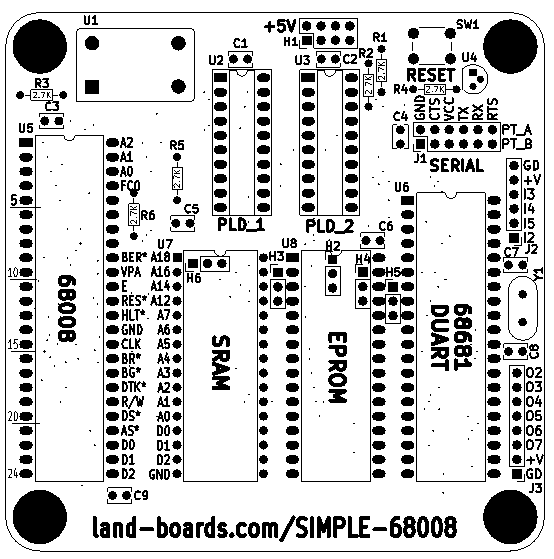
J1 - 2 port FTDI / TTL Serial
- GND
- CTS* (in)
- +5V
- Transmit (out)
- Receive (in)
- RTS* (out)
J2 - Input Port
- Input 2
- Input 5
- Input 4
- Input 3
- Vcc
- GND
J3 - Output Port
- GND
- Vcc
- Output 7
- Output 6
- Output 5
- Output 4
- Output 3
- Output 2
H1 - 5V Power
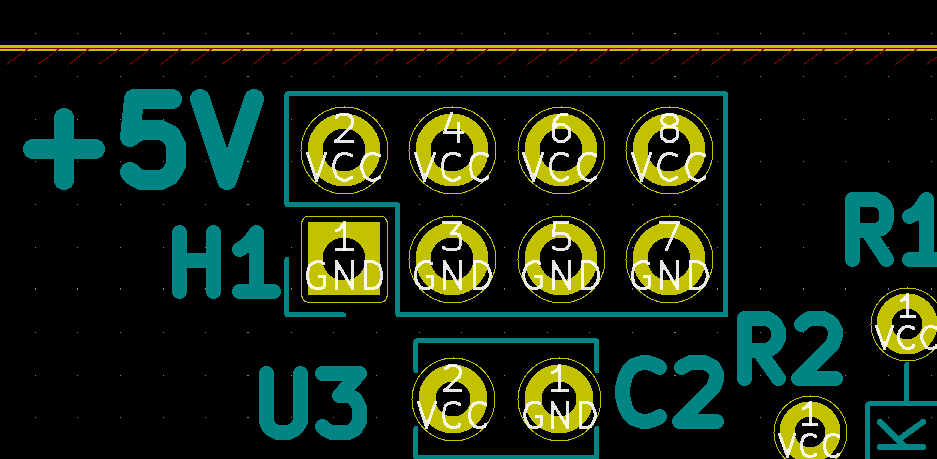
H2-H5 - EPROM/EEPROM Select Jumpers
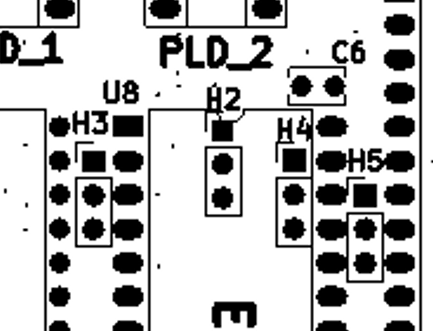
- H2 = EE PIN 31
- H3 = EE PIN 3
- H4 = EE PIN 30
- H5 = EE PIN 29
27SF256
- 27SF256 is a 28 pin part, socket is 32 pins
- H2 = Not installed
- H3-2 to H3-3 = A15 (Vpp on 27SF256, but pin can be either high or low)
- H4-1 to H4-2 = Vcc
- H5-2 to H5-3 = CPUA14
EEPROM Jumpers
| 27040
|
27020
|
27010
|
27512
|
27256
|
27128
|
2764
|
PIN(32)
|
PIN(28)
|
|
PIN(28)
|
PIN(32)
|
2764
|
27128
|
27256
|
27512
|
27010
|
27020
|
27040
|
| VPP
|
VPP
|
VPP
|
N/A
|
N/A
|
N/A
|
N/A
|
1
|
N/A
|
|
N/A
|
32
|
N/A
|
N/A
|
N/A
|
N/A
|
VCC
|
VCC
|
VCC
|
| A16
|
A16
|
A16
|
N/A
|
N/A
|
N/A
|
N/A
|
2
|
N/A
|
|
N/A
|
31 (H2)
|
N/A
|
N/A
|
N/A
|
N/A
|
PGM
|
PGM
|
A18
|
| A15
|
A15
|
A15
|
A15
|
VPP
|
VPP
|
VPP
|
3 (H3)
|
1
|
|
28
|
30 (H4)
|
VCC
|
VCC
|
VCC
|
VCC
|
N/C
|
A17
|
A17
|
| A12
|
A12
|
A12
|
A12
|
A12
|
A12
|
A12
|
4
|
2
|
|
27
|
29 (H5)
|
PGM
|
PGM
|
A14
|
A14
|
A14
|
A14
|
A14
|
| A7
|
A7
|
A7
|
A7
|
A7
|
A7
|
A7
|
5
|
3
|
|
26
|
28
|
A13
|
A13
|
A13
|
A13
|
A13
|
A13
|
A13
|
| A6
|
A6
|
A6
|
A6
|
A6
|
A6
|
A6
|
6
|
4
|
|
25
|
27
|
A8
|
A8
|
A8
|
A8
|
A8
|
A8
|
A8
|
| A5
|
A5
|
A5
|
A5
|
A5
|
A5
|
A5
|
7
|
5
|
|
24
|
26
|
A9
|
A9
|
A9
|
A9
|
A9
|
A9
|
A9
|
| A4
|
A4
|
A4
|
A4
|
A4
|
A4
|
A4
|
8
|
6
|
|
23
|
25
|
A11
|
A11
|
A11
|
A11
|
A11
|
A11
|
A11
|
| A3
|
A3
|
A3
|
A3
|
A3
|
A3
|
A3
|
9
|
7
|
|
22
|
24
|
OE*
|
OE*
|
OE*
|
OE*
|
OE*
|
OE*
|
OE*
|
| A2
|
A2
|
A2
|
A2
|
A2
|
A2
|
A2
|
10
|
8
|
|
21
|
23
|
A10
|
A10
|
A10
|
A10
|
A10
|
A10
|
A10
|
| A1
|
A1
|
A1
|
A1
|
A1
|
A1
|
A1
|
11
|
9
|
|
20
|
22
|
CE*
|
CE*
|
CE*
|
CE*
|
CE*
|
CE*
|
CE*
|
| A0
|
A0
|
A0
|
A0
|
A0
|
A0
|
A0
|
12
|
10
|
|
19
|
21
|
D7
|
D7
|
D7
|
D7
|
D7
|
D7
|
D7
|
| D0
|
D0
|
D0
|
D0
|
D0
|
D0
|
D0
|
13
|
11
|
|
18
|
20
|
D6
|
D6
|
D6
|
D6
|
D6
|
D6
|
D6
|
| D1
|
D1
|
D1
|
D1
|
D1
|
D1
|
D1
|
14
|
12
|
|
17
|
19
|
D5
|
D5
|
D5
|
D5
|
D5
|
D5
|
D5
|
| D2
|
D2
|
D2
|
D2
|
D2
|
D2
|
D2
|
15
|
13
|
|
16
|
18
|
D4
|
D4
|
D4
|
D4
|
D4
|
D4
|
D4
|
| GND
|
GND
|
GND
|
GND
|
GND
|
GND
|
GND
|
16
|
14
|
|
15
|
17
|
D3
|
D3
|
D3
|
D3
|
D3
|
D3
|
D3
|
H6 - SRAM Configuration
- 1-2 = 128KB SRAM
- 2-3 = 512KB SRAM
- 128KB and 512KB Parts are about the same price so there's not much point (if buying parts anyway) with going with 512KB part
SIMPLE-68008 Software
Linux Development Environment
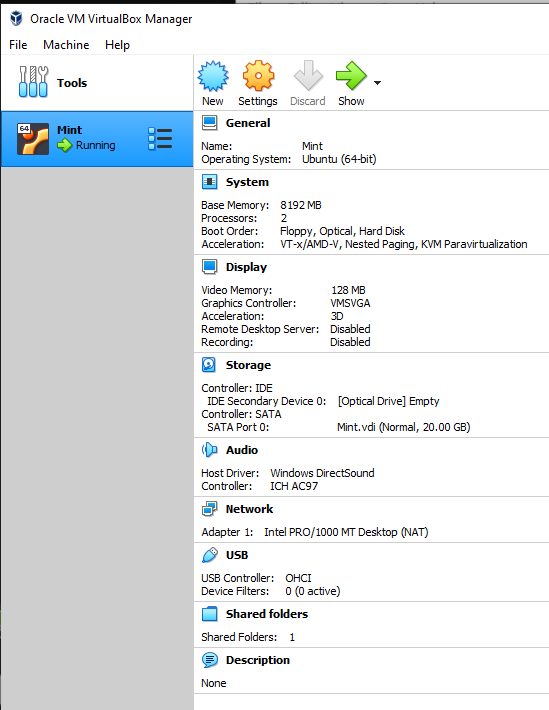
- Using Oracle VM VirtualBox
- Running Linux Mint
- The GNU C-Compiler with Binutils and other useful tools for 68000 cross development
- This is a Makefile based approach to build the toolchain to reduce the build time.
- The original work was by Steve Moody's page
- These tools are build:
- binutils
- gcc with libs for C/C++/ObjC
- vasm
- vbcc
- vlink
- newlib
S Record and Hex file manipulation
Initial Test Code
- S68K_001 - Test Code Repo
- Uses m68k assembly code toolchain
- Set up stack, starting address
- 68681 DUART code
- 9600 baud
- Initialize DUART
- Input/Output Serial routines
- Loop forever
68k-Monitor
- S68K_002 - Monitor Code Repo here
- Uses m68k assembly code toolchain
- Built from ChartreusK 68K monitor = 68901 DUART code
- Added S-Record load ('L' on command line)
- Runs at 38,400 baud with no waits/handshakes on transmit from Host Side
- Added improved SRAM test code
- Added SRAM fill
- Added 60 Hz timer code
- Long word timer at 0x608-0x60b
- Can be used as random number value if code is run from SRAM
Example Assembly Code
SIMPLE-68008 CPU
RAM Test Passed
> L
Load S-Record
+++++>
> R1000
Example C Code
- S68K_004 - C Code Example Repo
- Uses m68k assembly code toolchain
- Runs out of SRAM
- Loops forever
- Blinks LED connected to O2 (red LED, 4.7K resistor, wired to ground)
- Load and run
SIMPLE-68008 CPU
RAM Test Passed
> L
Load S-Record
+++++>
> R2000
String Test C Code
SIMPLE-68008 CPU
RAM Test Passed
> L
Load S-Record
+++++>
> R2000
Test Transmit Interrupt Code
- S68K_006 - Interrupt Test Code Example Repo
- Uses m68k assembly code toolchain
- Runs out of SRAM
- Loops forever
- Sends out alphabet forever using Transmit interrupt from 68681
- Required jumper U5-39 to U5-40 to always pullup VPA* to Vcc
SIMPLE-68008 CPU V1.00
RAM Test Passed
> l
Load S-Record
++++++++++++++++++++>
> r1000
SIMPLE-68008 CPU V1.00
RAM Test Passed
> r1100
42345678S:;<I>?@ABMDPFGHLJKE-6O8QRS00VW8 Z[\C^_`PbUd fghijkVm1o.qrst0vwx0z2
]R7AM:; =>T@ABeDEsGt JKLPNaPsRSsUVWXed[ >` bcdefghijklmnopqrstuvwxyz
23456789:;<=>?@ABCDEFGHIJKLMNOPQRSTUVWXYZ[\]^_`abcdefghijklmnopqrstuvwxyz
23456789:;<=>?@ABCDEFGHIJKLMNOPQRSTUVWXYZ[\]^_`abcdefghijklmnopqrstuvwxyz
23456789:;<=>?@ABCDEFGHIJKLMNOPQRSTUVWXYZ[\]^_`abcdefghijklmnopqrstuvwxyz
23456789:;<=>?@ABCDEFGHIJKLMNOPQRSTUVWXYZ[\]^_`abcdefghijklmnopqrstuvwxyz
23456789:;<=>?@ABCDEFGHIJKLMNOPQRSTUVWXYZ[\]^_`abcdefghijklmnopqrstuvwxyz
Receive Interrupt Test Code
- S68K_007 GitHub Repository
- Test interrupt from DUART
- Using receive character interrupt
- Runs from RAM
- Echos back character typed
- Downloaded as S Records
- R1000 to run program
60 Hz timer
- S68K_008 GitHub Repository
- Make a 60 Hz Counter in memory
- Use timer in DUART
- 3.6864 MHz / 16 = 23400
- 23,400 / 60 (Hz) / 2 per cycle = 1920 count = 0x780
- Increment a long in 0x604(-0x607)
- 60 Hz is 0x780 divisor
- Stop timer to clear timer
- Restart timer to set up interrupt on next timer edge
Guess a Number Game Code
- S68K_GAME_01
- Game to guess a number from 1-99
- Missing random number generator
- Structures string and DUART I/O code into separate files
- S68K_GAME_02
- Game to guess a number from 1-99
- Version adds random number generator
- Slightly less clumsy includes (added a main() stub and moved includes to right after that)
Sample Game
- Move an object around the screen using arrow keys
ANSI driver
Enhanced BASIC (Running from SRAM)
SIMPLE-68008 CPU
RAM Test Passed
> l
Load S-Record
+++++++++++++++++++++++++++++++++++++++++++++++++++++++++++++++++++++++++++++++++++++++++++++++++++++++++
+++++++++++++++++++++++++++++++++++++++++++++++++++++++++++++++++++++++++++++++++++++++++++++++++++++++++
+++++++++++++++++++++++++++++++++++++++++++++++++++++++++++++++++++++++++++++++++++++++++++++++++++++++++
+++++++++++++++++++++++++++++++++++++++++++++++++++++++++++++++++++++++++++++++++++++++++++++++++++++++++
+++++++++++++++++++++++++++++++++++++++++++++++++++++++++++++++++++++++++++++++++++++++++++++++++++++++++
+++++++++++++++++++++++++++++++++++++++++++++++++++++++++++++++++++++++++++++++++++++++++++++++++++++++++
+++++++++++++++++++++++++++++++++++++++++++++++++++++++++++++++++++++++++++++++++++++++++++++++++++++++++
+++++++++++++++++++++++++++++++++++++++++++++++++++++++++++++++++++++++++++++++++++++++++++++++++++++++++
++++++++++++++++++++++++++++++++++++++++++++++++++++++++++>
> R800
457232 Bytes free
Enhanced 68k BASIC Version 3.52
Ready
10 PRINT "HI"
RUN
HI
Ready
68K Monitor Plus Enhanced BASIC (Running from ROM)
- Puts S68K_002 - Monitor Code and Enhanced BASIC into a single 32KB ROM
- Build steps
- Run make for the Enhanced BASIC which pulls in the S68K_002 code
- EPROM base address = 0x80000
- 0x80000-0x83FFF - First 16KB reserved addresses for monitor (plenty of room for expansion)
- Code is from 0x80400-0x80caf (Less than 4KB)
- 0x84000-0x87FFF - Second 16KB reserves addresses for BASIC (plenty of room for expansion)
- Code is from 0x84800-0x87D1F (Less than 16KB)
- Boots into the monitor
- Run BASIC with 'B' on command line
- Runs at 38,400 baud
SIMPLE-68008 CPU V1.00
RAM Test Passed
> b
12
490032 Bytes free
Enhanced 68k BASIC Version 3.52
Ready
68000 fig-FORTH V1.0
SIMPLE-68008 CPU V1.00
RAM Test Passed
> l
Load S-Record
+++++++++++++++++++++++++++++++++++++++++++++++++++++++++++++++++++++++++++++++++++++++++++++++++++++++++++++++++++++++++++++++++++++++++++++++++++++++++++++++++++++++++++++++++++++++++++++++++++++++++++++++++++++++++++++++++++++++++++++++++++++++++++++++++++++++++++++++++++++++++++++++++++++++++++++++++++++++++++++++++++++++++++++++++++++++++++++++++++++++++++++++++++++++++++++++++++++++++++++++++++++++++++++++++++++++++++++++++++>
> r3648
68000 fig-FORTH V1.0
OK
OK
OK
1 2 3 OK
+ OK
+ OK
. 6 OK
Mechanicals
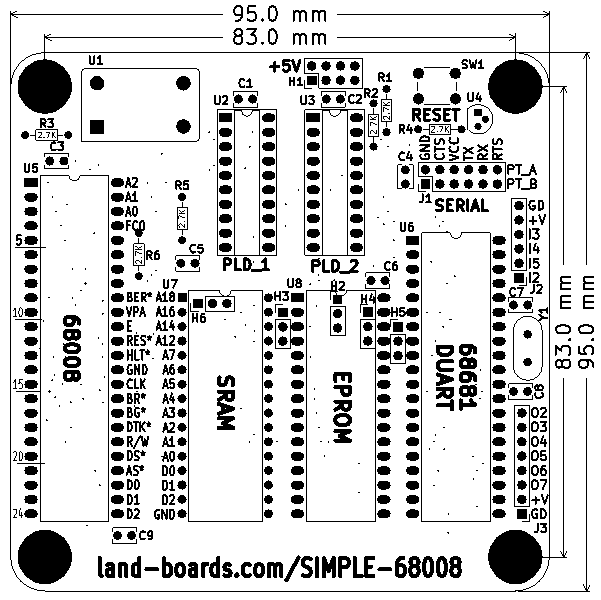
Checkout
Rev 2 Card
- Fixed DUART TXB and RXA connections (see Rev 1 rework)
- Added pullup to VPA* line (to make interrupts work - see Rev 1 rework)
- Add some silkscreen annotations for memory configuration header connections to rear of card
- Moved R6 up and added more silkscreen near CPU
Rev 1 Card
- VPA needs to be pulled up
- Reset working
- Reset switch and monitor working
- Clock working
- EPROM working
- SRAM working
- Checked Serial port
- Not using any XTAL capacitors
- Serial transmit/receive lines swapped
- TXB and RXA are swapped on DUART
- U6 pins 11 and 31 need to be swapped
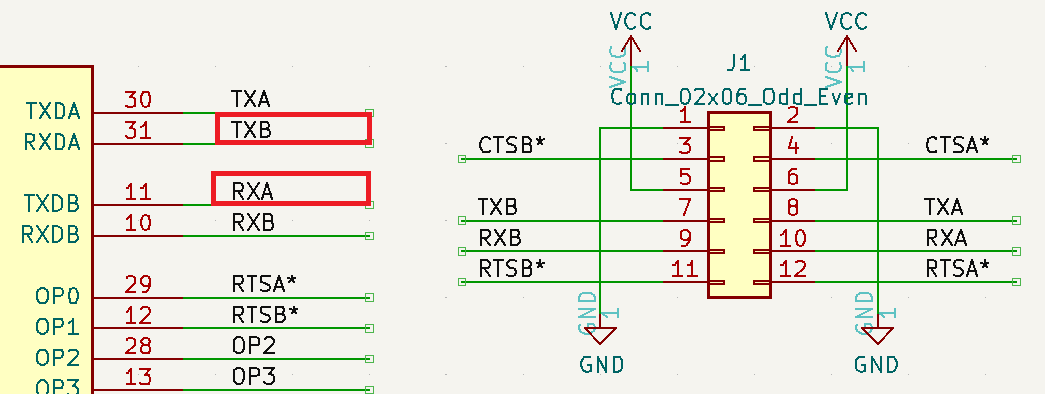
- Easiest cuts (on bottom of board)
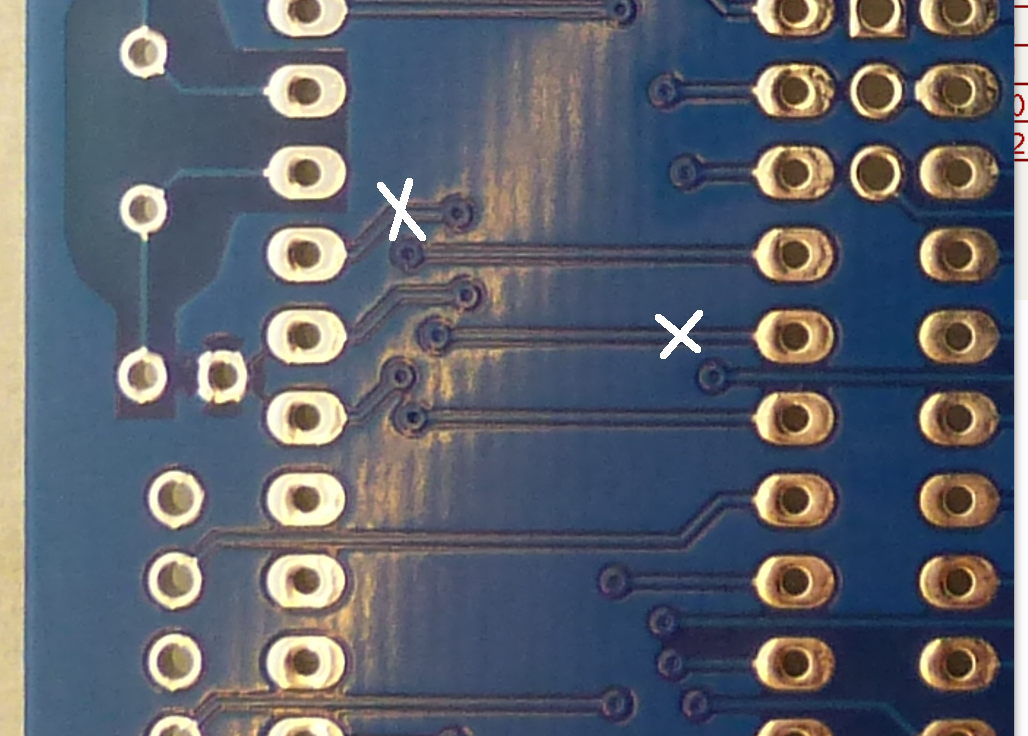
- Cuts as seen from the top side Silkscreen
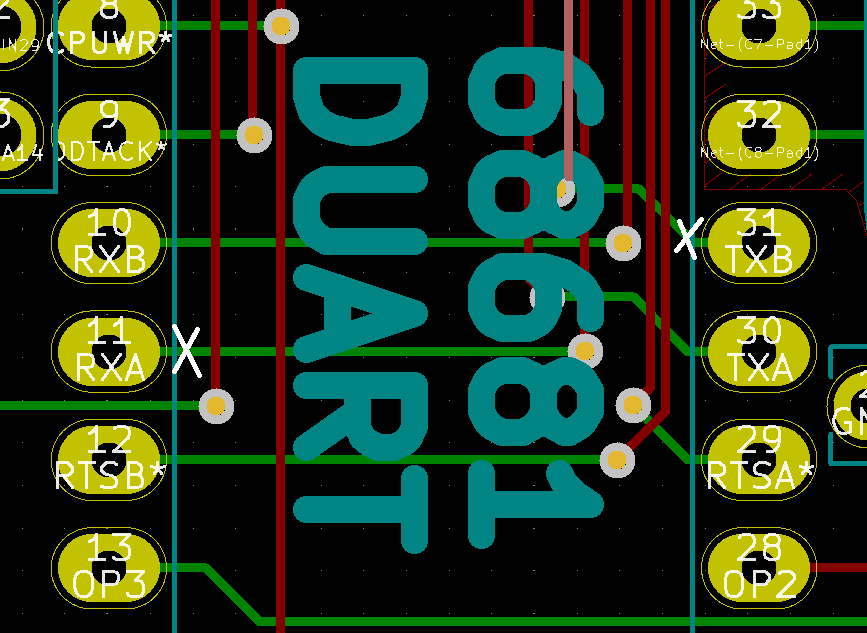
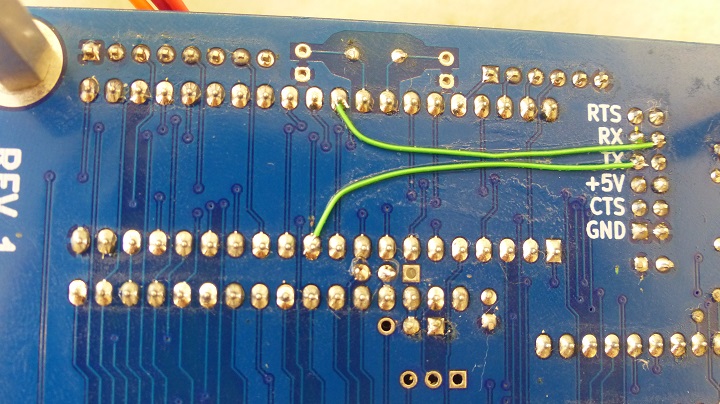
- Alternative cut (harder due to space and being on top of board)
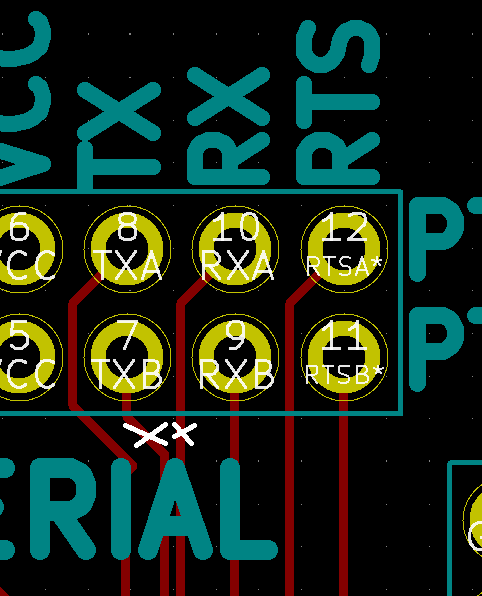
Assembly Sheet
Rev 1

























